There are two common misconceptions about Thornbury's former railway line: one is that it has disappeared completely, and the other is that the station was sited where Tesco's supermarket is today.
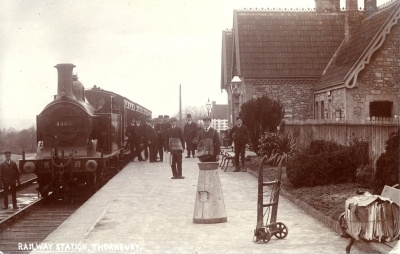
Thornbury Station about 1920. Notice the gas lighting and in the background the roof of the end house on the High St
Thornbury historian Meg Wise knows better, and her popular Heritage Walks help curious locals uncover the remaining traces of the line and the truth about where the station existed.
MyThornbury's Claire Jaggard tempted photographer Rich McD over from his native Chipping Sodbury (with the promise of cheese scones afterwards at Papilio's Coffee Shop!) to join her in following the Railway Heritage Walk route with Meg.
Read on to find out where to go and what to look for...
Modern photos on this page are courtesy of Rich McD Photography and historical photos have been supplied by Thornbury and District Museum.
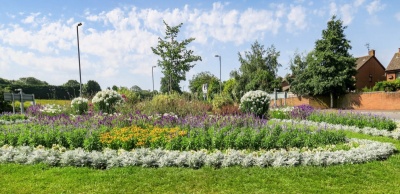
It seems an unusual place to start, but the Heritage Walk begins at Grovesend Roundabout, where Morton Way meets Midland Way, which is of course named after the Midland Railway Company.
From here, heading along Midland Way, you can see a hedgeline running between the fields on your left - these follow the route of the old railway line.
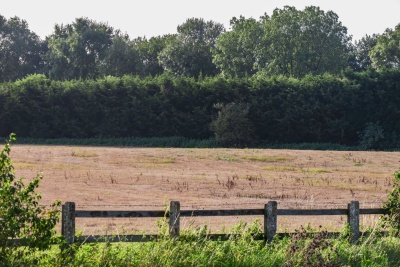
The single-track branch line opened in 1872, running from the main line at Yate to Thornbury via Iron Acton and Tytherington.
It was constructed by the Midland Railway Company, whose managers had perhaps been persuaded that the section to Thornbury would make the line more economic.
Midland Railway might have built the line to obstruct its rival the Great Western Railway Company, which was threatening to set up a route in the district.
Parts of the original track are still owned by Network Rail and still in use at Tytherington Quarry.
Bringing the line to Thornbury was expensive, due to the height of the ridge between Tytherington and the town and the natural slope of the land down towards the River Severn.
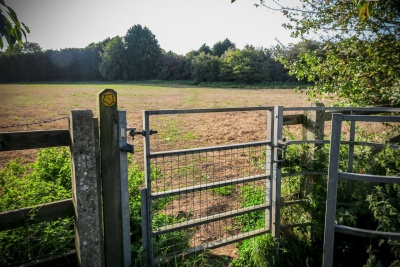
A tunnel, a cutting through limestone and an embankment had to be constructed, which still resulted in a steep gradient of about 1 in 60. The process took longer than expected.
Passenger numbers were not very high and only a few trains ran each way daily.
In the early years the line was sustained by the carriage of ironstone mined at Frampton Cotterell, which connected to Iron Acton via a branch line.
Later on the main income came from transporting stone from the quarries at Tytherington.
If you're feeling energetic, you can follow a footpath across the field bordering Midland Way and go over two stiles where the line used to be.
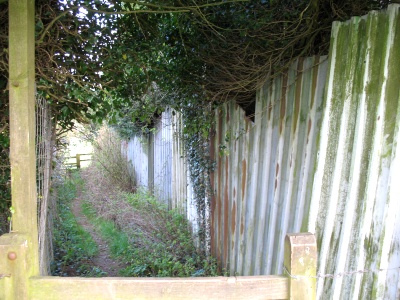
The footpath & stiles where the white bridge crossed the line.
Beware any cows in the fields, and the plentiful brambles!
There used to be a white footbridge here that allowed pedestrians to cross the track - maybe this was the inspiration for naming Whitebridge Gardens?
From the other side of the track take a moment to enjoy a great view of Thornbury and the River Severn.
The Grovesend Tunnel still exists but the entrance is now blocked and on private land, so inaccessible.
If you walk a little further along Midland Way, you can still see the double gates on the road that show where the track used to emerge.
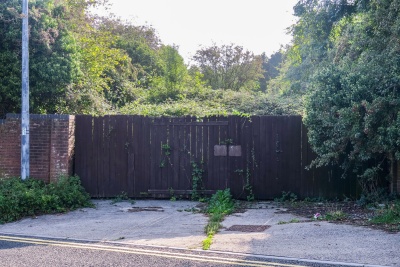
Meg told us that the engine drivers would sometimes stop the train so that they could pick field mushrooms, gather watercress that grew in the cutting near the tunnel or shoot rabbits.
This had to be done with caution, and only with short trains, as restarting the engine on the steep gradient could be tricky.
One day the driver of a passenger train shot a rabbit and retrieved it without stopping the train!
As a safety measure on the single-track route, the Yate signalman would hand a metal staff to the engine driver. At the terminus this would be handed to the station master at Thornbury.
No driver could enter or leave the line without this staff. A key on the end of the staff worked the ground frames at the side of the tracks.
Sometimes this staff went missing as vibrations caused it to slip off the train. Once, after a long search, it was found sticking out of a lineside water trough.
On another occasion the staff could not be found and a replacement had to be made. If houses are built on the other side of Midland Way, the lost key may yet turn up.
The Thornbury branch staff and key is on display at Thornbury and District Museum.
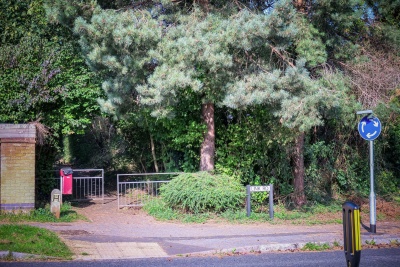
Leave Midland Way at Link Road and pick up the footpath that starts by the street sign.
The path follows the line of the old track along the top of the raised embankment - you're now walking where the trains used to run!
You'll notice here that the footpath is significantly higher than the relatively modern houses built around it - now you know why.
The embankment would have required constant maintenance to repair the damage caused by weathering and burrowing rabbits, and Midland Railway may well have regretted their initial investment.
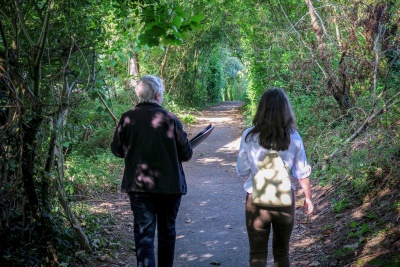
The generous width of the footpath suggests that the embankment was designed to accommodate a double track, but only a single one was ever installed as a plan to extend the route beyond Thornbury never came to fruition.
The first public train ran on 2nd September 1872. The Bristol Times & Mirror reported: “The Tockington Band in its uniform led a large concourse of people up the High Street from The Swan to welcome the first train at 10am.
At the railway station scarcely standing room could be obtained, so great was the crush of people, several thousands of persons having assembled there to await the arrival of the first train from Bristol. Most shops closed at 11.30am; streets were decorated with flags and floral arches; while bells rang from the parish church.
At 1.30pm 725 school children from the Church of England, Dissenting and Union schools accompanied by their teachers and the Alveston band, travelled in an 18 coach train to Yate at 4d return per head, the cost being defrayed by public subscription.
When they arrived back at Thornbury, the children were let out for a run near the station in fields lent by Mr R Scarlett solicitor. Here they sat down to a substantial tea, the cake provided by Mr Vowles, the Thornbury baker.”
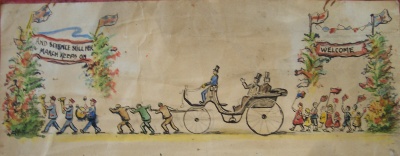
Local historian Mary Bruton's illustration of the scene in Thornbury High Street on the opening day. The Mayor was pulled in triumph to the Swan following his arrival on the first train from Bristol.
The Mayor J C Gwynn announced:
“Fellow townsmen, this is a redletter day in the annals of Thornbury.
This town is the centre of a large and wealthy agricultural district and I do not doubt that the markets will be greatly increased and before long we shall have a connection with South Wales.”
Celebrations continued into the evening with a fireworks display.
At least one of the children who travelled on the first day was present at the ceremony when the line closed to passengers in 1944.
In the early years most of the trains were mixed, carrying both passengers and freight.
Goods that were brought to Thornbury included grain, the post including parcels, some draught beers, salt, newspapers, animal feed, farm implements and fertiliser.

Midland Railway staff & coalyard proprietors had their photo taken for the 50th anniversary of the line in 1922
Bricks were sourced around the country, probably undermining the trade of local brickworks at Littleton and Oldbury-on-Severn. Irish cattle were occasionally brought in for special sales in the town.
The main import was coal largely for domestic use but also for Thornbury Gas works, which received 4 to 5 wagons of coal weekly.
Goods leaving the town by train included the post, eggs, cheese, milk, sugar beet, hay, cattle and sheep with up to a dozen cattle vans being taken to Bristol on market day.
Thornbury sawmills dispatched seed boxes, railway sleepers, pit props and wooden crates to hold tinplate metal sheets produced by the smelters at Avonmouth and South Wales.
The commercial fishermen at Oldbury-on-Severn sent their salmon, packed in straw-lined baskets, for sale at Bristol or for onward travel to be sold in London.
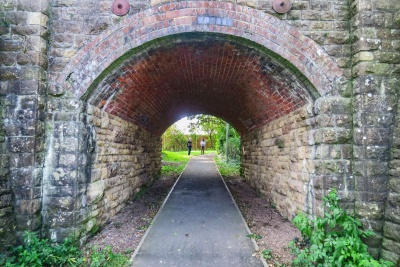
The footpath crosses a bridge - you'll notice the stone parapets each side of the embankment as you walk along.
If you take a small diversion down to your left you'll find the underline bridge in perfect rounded shape, wide enough for the cattle that were once driven through from fields either side of the line.
The initial building of Thornbury's railway line was a controversial local issue, with some landowners using it as an opportunity to make money, and others opposing it because it affected their hunting rights.
Henry Howard was apparently a conditional supporter - happy to welcome the new railway as long as it was kept a safe distance from his seat at Thornbury Castle.
The construction of the branch line involved about 800 navvies. Some lodged with their families in Thornbury and stayed long enough to see their children born in the town.
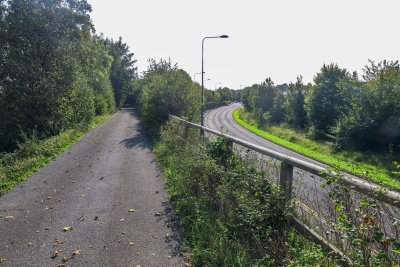
A number were sacked on suspicion of poaching. In December 1869 the press reported that a navvy caused a disturbance in Tytherington Parish Church by walking up to the pulpit during the sermon, taking hold of the clergyman’s surplice and telling him to read louder!
The heavy manual work was often dangerous at a time of few health and safety measures. An inquest into the death of excavator William Jervis whose foot was crushed by a stone, showed that he died from blood poisoning after an operation to amputate it.
The embankment continued nearly all the way to the top of the High Street. The height of much of the station yard area was altered when Midland Way was constructed, followed by Tanners Court, new housing and the entrance to Tesco supermarket.
Today the embankment makes a great footpath and cycle track!
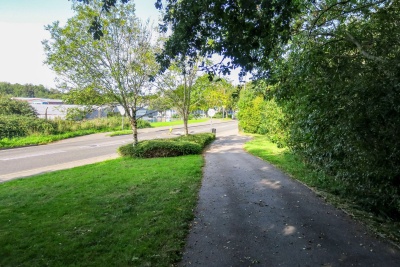
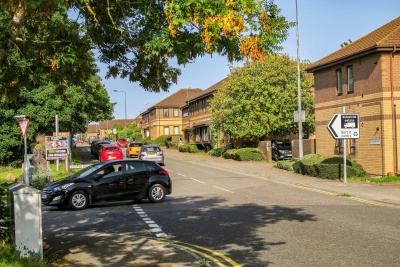
You'll emerge from the footpath opposite the entrance to Thornbury's industrial estate.
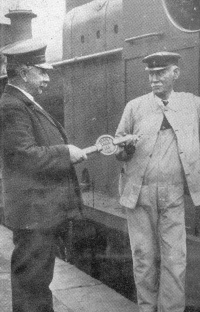
Philip Cooper and Bill Short with the branch line staff and key 1937
Cooper Road ahead of you was named after two Thornbury station masters – Charles Radcliffe Cooper followed by his son Philip, who between them ran Thornbury Station for approximately 50 years from about 1887 to 1937.
Short Way honours Mr William Short the engine driver. Bill, as he was known, took charge of the Thornbury locomotive department following the retirement of Alfred Gill in 1929.
He continued in this role until 1937 when the Thornbury Gazette featured a photograph of both Philip and Bill, holding the branch staff and key, to mark their joint retirement.
Isambard Kingdom Brunel had nothing to do with this railway, so the naming of Brunel Road appears to be a travesty!
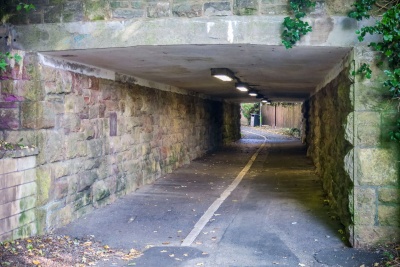
Cross Cooper Road and take the footpath by Essilor's blue railings to see a second underline bridge – this one was altered when Midland Way was built, which explains the different shape to the first.
This bridge originally allowed safe passage to the station master from his house (sited inside Essilor's railings) to the station on the other side of the track.
It's still in use today as a footpath and cycle path to Tesco's supermarket...
... which brings us to the Tesco myth; Meg Wise is very clear that the supermarket was built on land belonging to a house known as The Villa adjacent to the area owned by Midland Railway.
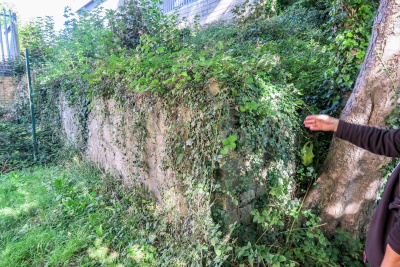
You can still see remnants of the original southern boundary wall between the two across from the dog leg of the blue fence further down the footpath.
There was no station master living in Thornbury after about 1956 as the Thornbury yard was run from Yate.
However, the station master's house was leased by railway worker Ron Davis who still worked at the station as a ganger.
Ron and his wife Mary Ellen brought up their children in the house, living there for 23 years. The family used to park their car under the bridge!
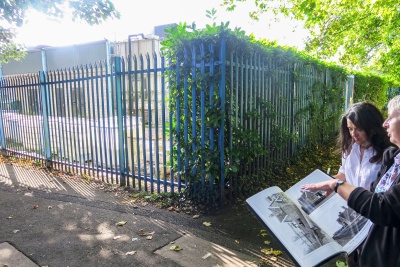
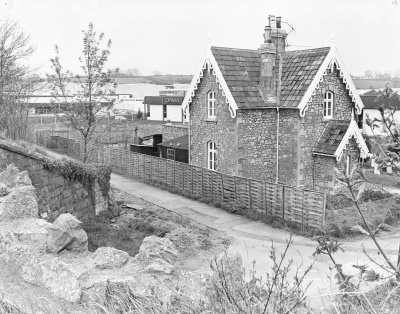
The Station Master's house 1970s. The industrial estate is being established nearby. Notice the sign for Orma, now Essilor.
Ron retired in 1978 and the following year the couple were forced to move out by Northavon District Council, which was by then the owner of the site.
The building was demolished and became part of the industrial estate.
Notice that the line bridge is wide enough to allow access by vehicles. Presumably the station masters were originally expected to own some sort of horse-drawn conveyance - although the Coopers seem to have preferred bicycles!
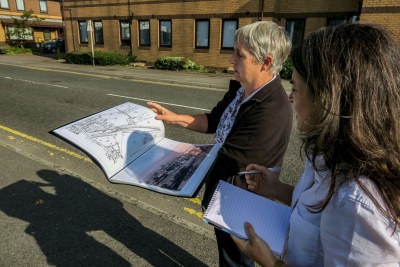
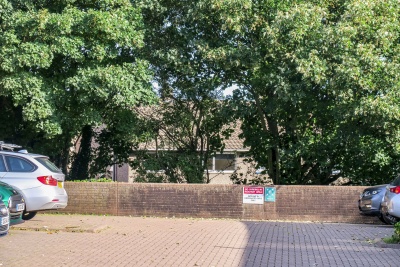
The top of the bridge is visible on the other side of the road at the back of Burton Sweet's car park, and the modern wall at the back of Sovereign IFA's car park shows the height difference between the embankment and the houses below.
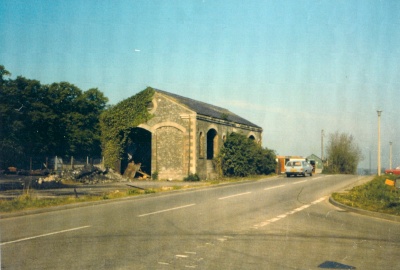
Thornbury Goods Shed. This remained for a number of years following the construction of Midland Way but was eventually demolished to make way for industrial units.
In the middle of the station yard there was a turntable to allow the engines to be turned to travel back towards Yate - more or less on the spot of the current mini roundabout where Midland Way meets Rock Street.
The boundary wall of station land is clearly visible from the car park behind Cromhall Refinishing - note the line of lime trees and the stonework visible at the dog leg of the car park edge.
Beyond the turntable was the stone-built goods shed, roughly where Screwfix is today.
The three sidings here, which extended nearly to the Bristol Road, housed a number of coal merchants including Ernie Ball, Ted Watts (later Thornbury Coal Company) and Fred Davis.
Passing to the green space beyond the industrial units, the footpath entrance and roadway to Tesco break through the original boundary wall of the station yard.
Next time you walk past the old yew tree at the corner of Rock Street and Midland Way, take note. The tree grows atop a small mound - as Meg explained, this is another sign of the original height of the embankment.
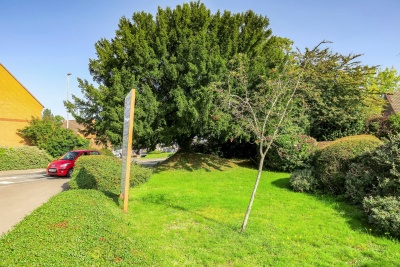
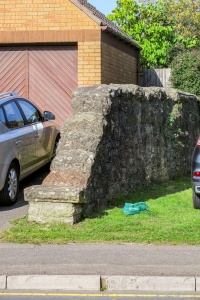
The tree can be spotted on various historic photographs and luckily developers have allowed it to continue growing peacefully, despite drastic change all around it.
From the yew tree site, you can see remains of the station's northern boundary wall on the opposite side of Rock Street, behind new houses and alongside a small green area.
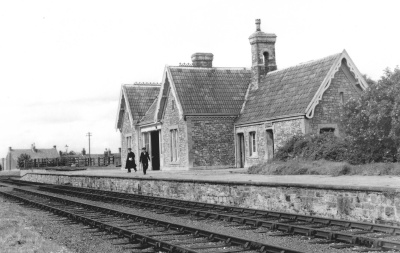
Thornbury Station House late1950s/early 1960s. Notice the cattle pens and the roof of the last house on the High Street.
Sadly, the handsome old station building was pulled down soon after the closure of the line in 1966. It was a stone twin-pavilion construction with fretted barge boards and a tiled roof.
The single platform was illuminated by 4 gas lamp posts. Beyond the station house were cattle pens and a cattle loading dock.
The station house was positioned roughly where houses no.s 8 and 10 now sit on Midland Way.
The service road behind Tanners Court was originally the way that led to the front of the station house from the main entrance near the top of the High Street.
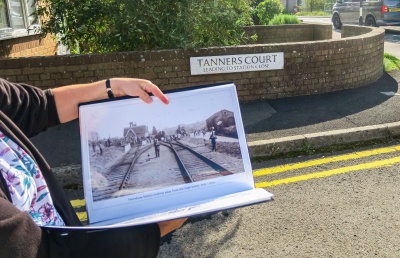
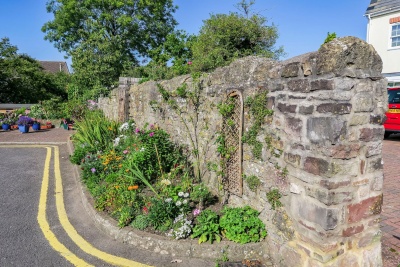
It is marked to the right by the old wall running behind the modern houses and to the left by the back-garden wall of Townsend House, once the last house on the High Street.
On the High Street itself, look closely at the side of no.81 (Townsend house) and you'll see the remains of the gate post marking the old station entrance.
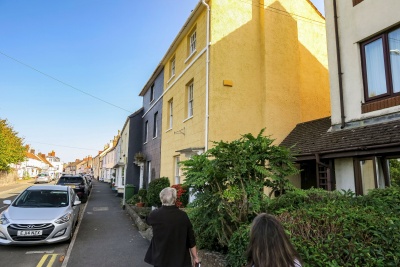
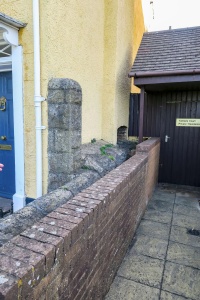
There's also an open fireplace set into the wall, showing where the Cossham family intended, but failed, to add on more houses to the row.
Thornbury and District Museum have a sketch of how the station entrance used to look, but no photographs, so if you or anyone you know has one tucked away, they'd love to see it! Please get in touch by email: .
Town parades mustered on the second road into the station yard, which served the goods shed and coalyards.
Here there was plenty of space to gather before heading down the High Street - unlike today when parades assemble at Castle School and disband at Rock Street car park, parading in the opposite direction.
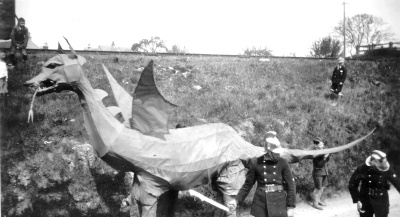
The dragon was part of the Silver Jubilee parade in 1935. Notice the cattle pens to the right and the height of the embankment near to the High Street.
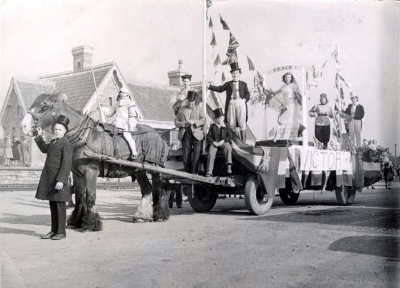
Part of the parade for the Peace Celebration in 1945. The horse and waggon came from the saw mills.
Thornbury's railway was a financial headache from the start and passengers wanting to travel directly to Bristol found that it was cheaper to use horse buses, which took them to Patchway Station or into Bristol itself.
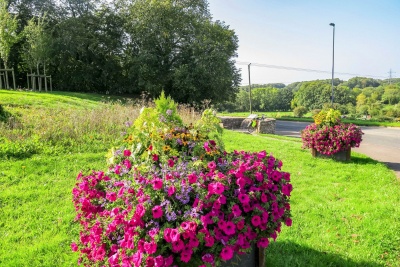
In 1906 the Bristol Tramways Carriage Company started operating a motor bus service linking Thornbury with the tram terminus at Horfield. The buses ran more frequently than the trains.
The original plan to extend the line to Wales was abandoned early on. Had this gone ahead, a bridge would have been built across the top of the High Street - the entrance to Thornbury and the town's character would have been very different as a result!
During WW2 civilian train travel was reduced by law but troops and their equipment continued to use the station, including soldiers rescued from the beaches of Dunkirk.
On 2nd June 1940, when 375 young children and 29 teachers, evacuees from Harwich, arrived, the Gazette reported “When the crowded train steamed into Thornbury Station eager faces could be seen peeping from every window.”
Their journey, on a very hot day, had taken nearly 10 hours.
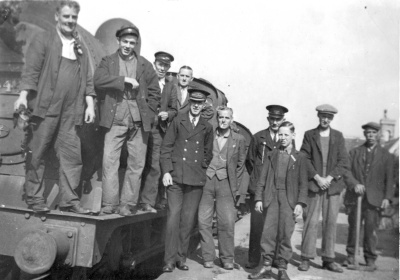
The railway men at Thornbury Station on the day of the last passenger service in 1944
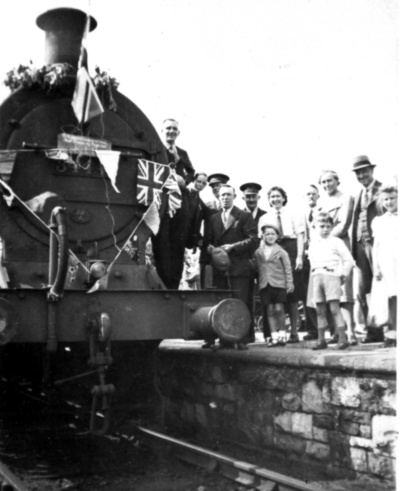
The last passenger train in 1944
On 19th June 1944 branch passenger services on the line were withdrawn. Goods continued to be carried.
The first ambulance train carrying patients bound for the United States’ Army Hospital at Tortworth came in April 1944. Hundreds of wounded soldiers arrived in June following the D Day landings.
Vehicles were brought to the station in advance of a train’s arrival time and roads were closed to allow the quicker movement of hospital transport.
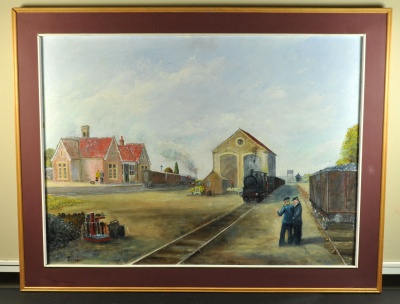
Painting by local artist Jeff Screen, born in Thornbury - his memories of the station, on display at the museum
The news that a train was going to arrive spread quickly and local children would wait on the railway embankments hoping to be thrown chocolate and chewing gum by less badly injured, generous American soldiers.
From April 1944 to February 1945 approximately 3000 wounded were brought through Thornbury Station.
In the 1950s members of railway enthusiasts’ clubs were occasionally able to visit the station by specially arranged trains.
From 1962 the branch was used to bring in items like bulk cement and steel that were used in the construction of the Severn Bridge and the nuclear power station at Oldbury-on-Severn, both a few miles from Thornbury.
The line was closed in June 1966. However, Yate Station reopened in 1989 and track was relaid for the use of Tytherington Quarry in the early 1970s.
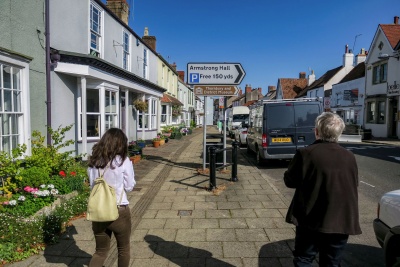
We're incredibly grateful to Meg Wise for taking the time to lead our "Discovering Thornbury's Hidden Railway" walk, and for sharing her encyclopaedic knowledge on the subject, as well as other experts from Thornbury and District Museum for their support.
Please visit thornburyroots.co.uk to find out more about the railway at Thornbury.
Do try following in our footsteps. The route takes a couple of hours at most, and - apart from the diversion across the fields - is along pavements and footpaths, so accessible for most ages and abilities.
You'll end up on Thornbury High Street, where there are plenty of places to treat yourselves to a well-earned cuppa - just the ticket!